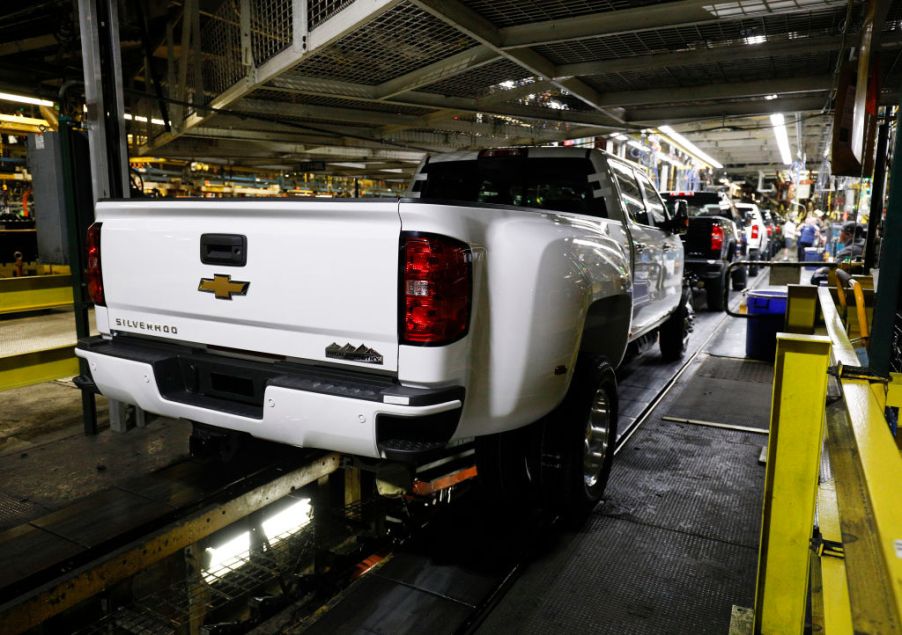
How Much Does Adding Dual Rear Wheels to a Truck Cost?
In 1973, GM came out with the first dually pickup truck. Dually trucks had previously been available but didn’t come with a pickup bed. These trucks were only available as commercial trucks or chassis cabs. Ford’s own dually pickup truck appeared in 1980. Is a dually pickup truck right for you though? And how much does it cost to choose this pickup style?
The advantages of dual rear wheels
Trucks that have two pairs of rear wheels (and the usual two wheels in the front) are called dual rear wheel, DRW, or dually trucks. Having six total tires is useful for commercial and heavy-duty trucks, since it helps them safely haul and tow more.
Those dual rear wheels give the truck additional safety and stability when it’s hauling or towing something extra heavy, like a horse trailer, boat, or RV. The extra tires can also provide added control if one tire blows out, letting the truck be driven to safety on the remaining three rear tires.
While the advantages are a big deal, dually trucks do have worse fuel economy, a bumpier ride without a load, and a higher price tag. These trucks also harder to park.
The science of dual rear wheels
The physics and engineering of dually trucks explain their benefits. The extra rear wheels offer more stability by helping to spread out the weight of the payload. They also give the truck extra road contact, which increases both balance and stability. That’s especially important under windy conditions.
There are other design differences that make the dually truck great for hauling and towing. These trucks have stronger, larger rear axles, and they also need to have a wider fender to cover all four wheels. The rear axle has a full-floating configuration, where the bearing hubs on the ends of the axle bear the truck’s weight rather than the axle. The axle does transmit torque. This design style is able to carry more weight.
You’ll pay for the extra wheels
While dual rear wheels appear on RVs, commercial trucks, and one-ton trucks, they’re also featured on some heavy-duty trucks. Ones to consider are the Ford F-350, Chevy Silverado 3500 HD, the GMC Sierra 3500 HD, and the Ram 3500. Bigger options include the Chevrolet Silverado 4500 HD, 5500 HD, and 6500 HD.
Of the numerous Ford F-series truck options, the F-250 only comes with single rear wheels and the F-450 only has dual rear wheels. Buyers have a choice on the F-350 trims. Depending on the trim, choosing dual rear wheels increases the price between $1,275 and $2,005, except on the F-350 King Ranch where the price actually decreases $1,510.
On the Ram 3500, adding dual rear wheels increases the price between $895 and $1,395, depending on the trim, cab, and bed length. Dual rear wheels aren’t available on the Chevrolet Silverado or Silverado 2500 HD, but buyers can select them on the Silverado 3500 HD. While not available with the standard bed and crew cab, it costs $1,200 on any trim to add dual rear wheels to the long bed with regular, double, or crew cab.
Is it worth it?
Are the extra wheels worth the extra cost? They may be for buyers who need to increase their hauling and towing capacities. For example, when looking at the 2020 Chevy Silverado 3500 HD, a comparison of the DRW version with the single rear-wheel (SRW) version demonstrates the differences.
When both trucks have regular cabs and 6.6-liter V-8 turbo-diesel engines with 10-speed transmissions, the DRW truck can haul 2,215 pounds more (6,517 lbs. vs. 4,302 lbs.). The DRW truck can also tow 5,500 pounds more conventionally (20,000 lbs. vs. 14,500 lbs.) and an impressive 14,000 pounds more in gooseneck or fifth-wheel towing (35,500 lbs. vs. 21,500 lbs.).
While choosing a dually pickup truck does generally increase the price, it can be worth it for drivers who have super heavy loads to haul or tow.


